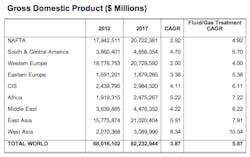Fluid/Gas Treatment and Control Market to Reach $403 Bil. in 2017
The market for equipment, services and chemicals used in treating and controlling liquids, indoor air, stack gases, and process fluids will grow from $381 billion in 2012 to $403 billion in 2017, according to the latest forecast by McIlvaine.
McIlvaine predicts in its online report “Fluid/Gas Treatment and Control Markets“ that the market will grow at the rate of gross domestic product (GDP) plus 2 percent, so while GDP in NAFTA will be just under 3 percent per annum, the growth in the fluid/gas market will be close to 5 percent, West Asia will see the largest percentage growth, while East Asia will account for the bulk of the revenue increases. This is due to the construction of power, water, wastewater, and other basic industrial plants.
McIlvaine says the reasons that this market will grow at a faster rate than GDP are:
- Increasing recognition of the scarcity of clean water for human consumption
- More affluent populace which is capable and willing to clean up the wastewater to minimize health threats and maximize recreational enjoyment
- Recognition of the necessity of removing fine particulate, heavy metals, and acid gases from industrial stack discharges
- Product and personnel requirements for clean in-plant air
- Recognition of the value in better purifying residential and commercial air space.
- Growth of clean space, including semiconductors, biopharmaceuticals, and other high-tech industries
- Increased investment in air and liquid purification by the healthcare industry.
For more information about the “Fluid/Gas Treatment and Control: World Markets” report, click here.


